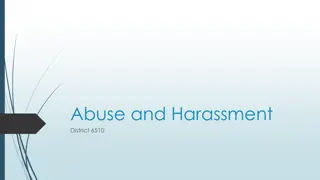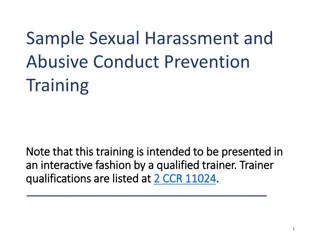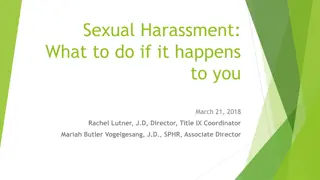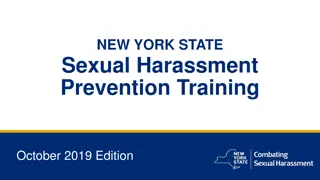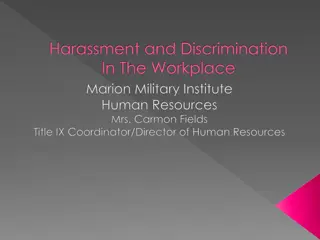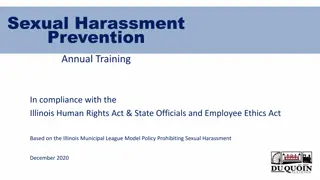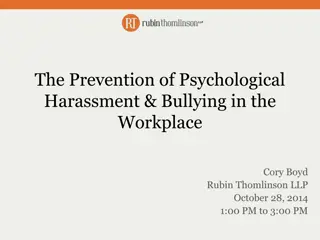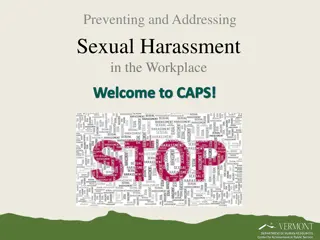Understanding Sexual Harassment of Women in the Workplace
Sexual harassment of women in the workplace is a serious issue that involves unwelcome sexual behavior such as physical contact, demands for sexual favors, making sexually colored remarks, and more. The Sexual Harassment of Women at Workplace (Prevention, Prohibition, and Redressal) Act, 2013 prohibits such behavior and provides guidelines for prevention and redressal. This form of harassment is not about sex but about power dynamics, aiming to undermine women's roles, capabilities, and leadership in the professional sphere.
Download Presentation

Please find below an Image/Link to download the presentation.
The content on the website is provided AS IS for your information and personal use only. It may not be sold, licensed, or shared on other websites without obtaining consent from the author. Download presentation by click this link. If you encounter any issues during the download, it is possible that the publisher has removed the file from their server.
E N D
Presentation Transcript
Human Rights of women in danger By Prof. Dr. V.S. Elizabeth National Law School of India University
It is unwelcome sexually determined behaviour It is any conduct that is sexual in nature and unwelcome It entails blackmail, threats or pressure and is manifested directly or indirectly in acts that range from very subtle behaviour to open sexual aggression
The Sexual Harassment of Women at Workplace (Prevention, Prohibition and Redressal) Act,, 2013 Sexual Harassment includes any one or more of the following unwelcome acts or behaviour (whether directly or by implication) namely:- Physical contact and advances; or A demand or request for sexual favours; or Making sexually colored remarks; or Showing pornography; or Any other unwelcome physical, verbal or non-verbal conduct of a sexual nature
3. (1) No woman shall be subjected to sexual harassment at any workplace (2)The following circumstances, among others, if it occurs or is present in relation to or connected with any act or behaviour of sexual harassment amy amount to sexual harassment:- (i) Implied or explicit promise of preferential treatment in her employment; or
(ii) implied or explicit threat of detrimental treatment in her employment; or (iii) implied or explicit threat about her present or future employment status; (iv) interference with her work or creating an intimidating or offensive or hostile work environment for her; or (v) humiliating treatment likely to affect her health or safety.
There are very many complex reasons Basically because of the unequal power relations between men and women in society which is also reflected in the workplace Sexual Harassment is not so much about sex as about power It is a mechanism used to debase the role of women in the workplace, their professional capabilities and their leadership abilities and to draw attention to their sexuality while at the same time undermining the exercise of power or authority by women
Womens socially conditioned lack of assertiveness in resisting and reporting instances of intimidation and coercion Socialisation which leads men and women to think that seduction, overt or otherwise, forms part of any relationship between men and women. Growing insecurity of men with the increasing number of women in employment so Sexual Harassment becomes a means by which women are put in their place Those who indulge in Sexual Harassment see women as sexual objects existing to provide them sexual gratification
Sexual Harassment affects the dignity of a woman Sexual Harassment jeopardises equality of opportunities in the workplace and the right to sexual freedom thus it violates fundamental Constitutional and Human Rights It is a form of violence against women It creates a hostile work environment It affects the health of those subjected to such harassment
Myth If you ignore sexual harassment it will go away. Fact It will not. When women ignore sexual harassment it is often interpreted as a sign of approval Myth Women enjoy being sexually harassed Fact Women don t enjoy being sexually harassed. It s usually a humiliating and frustrating experience
Myth Women who say No actually mean Yes Fact When women say no they mean no . This is a common way of negating women s ability to make choices. Gender stereotyping of men as sexually aggressive and women as sexually passive and available allows men to proceed even when told that their advances are unwelcome.
Myth Sexual harassment is normal behaviour; a woman should feel complimented Fact Sexual harassme nt is not normal behaviour; it is a manifestation of power relations and a serious form of gender discrimination. It can have a devastating impact physically, emotionally and psychologically. Research shows that women are often forced to leave school or their jobs to avoid harassment
Myth I will not be able to compliment someone without being accused of sexual harassment Fact Compliments by themselves are not considered as sexual harassment. Sexual harassment is defined by its impact on the harassed and the work environment and not the intent of the harasser.
Myth Women keep quiet so they must like it Fact Women keep quiet believing that if they ignore it will stop, that if they protest or complain things will get worse.
Feel humiliated Confused Angry Guilty (in a social environment which places the blame on women for any form of sexual assault on them.) Affects physical, mental and emotional wellbeing Quality of their work, as well as that of others
Security of employees is the responsibility of the employer Sexual Harassment affects the safety of women employees Labour law requires employers to protect the constitutional rights of employees Sexual Harassment results in violation of the Right to Equality, Right against Gender Discrimination, Freedom to pursue any profession, occupation or business and the Right to Life and Personal Liberty
Right to Equality Article 14 Equality before the law - The State shall not deny to any person equality before the law or the equal protection of the law within the territory of India Article 15 Prohibition of Discrimination on grounds of religion, race, caste, sex or place of birth (1) The State shall not discriminate against any citizen on grounds only of religion, race, caste, sex, place of birth or any of them.
Article 15 (3) Nothing in this article shall prevent the State from making any special provision for women and children
Right To Freedom Article 19 Protection of certain rights regarding freedom of speech, etc. (1) All citizens have the right - (g) to practice any profession, or to carry on any occupation, trade or business Article 21 Protection of Life and Personal Liberty - No person shall be deprived of his life or personal liberty except according to procedure established by law.
Right To Constitutional Remedies Article 32 Remedies for enforcement of rights conferred by this Part (1) The right to move the Supreme Court by appropriate proceedings for the enforcement of the rights conferred by this Part is guaranteed. (2) The Supreme Court shall have power to issues directions or orders or writs, including writs in the nature of habeus corpus, mandamus, prohibition, quo warranto and certiorari, whichever may be appropriate, for the enforcement of any of the rights conferred by this Part
Article 42 Provision for just and humane conditions of work and maternity relief The State shall make provision for securing just and humane conditions and for maternity relief. Article 51 Promotion of international peace and security The State shall endeavour to (c) foster respect for international law and treaty obligations in the dealings of organised peoples with one another;
Human rights are those rights that every human being possesses and is entitled to enjoy simply by virtue of being human Human rights are a group of ethical principles having a legal dimension, arising out of the need of each and every individual to enjoy the conditions essential for a decent life.
Human rights are based on the fundamental principle that all persons possess an inherent human dignity and that regardless of sex, race, colour, language, national origin, age, class or religious or political beliefs, they are equally entitled to enjoy their rights
All human rights are universal, indivisible, interdependent and interrelated 1993 World Conference in Vienna specifically recognised the human rights of women and the duties of states to protect and promote such rights, including the right to freedom from violence.
VIOLATION OF THE RIGHT TO IDENTITY RIGHT TO AFFECTION RIGHT TO PEACE AND ENRICHING PERSONAL RELATIONS RIGHT TO PROTECTION RIGHT TO PERSONAL DEVELOPMENT
RIGHT TO SOCIAL AND POLITICAL PARTICIPATION RIGHT TO FREEDOM OF EXPRESSION RIGHT TO AN OPTIMUM STATE OF PHYSICAL AND MENTAL HEALTH
The Discrimination Against Women affirmed that violence against a violation of her internationally recognised human rights regardless of whether the perpetrator is a public official or a private person. Regional Courts of interpreted state action to include the failure of the state to prevent violence Committee on Elimination of woman constitutes a Human Rights have
According to this criterion, the State becomes a de facto accomplice if it does not offer women the necessary protection from violations of their rights, or when it acts in discriminatory fashion by not preventing or punishing acts of gender-based violence, women equal protection under the law Scholars and human rights groups have argued that a state s failure to prosecute individuals who are violent against women constitutes a violation of equal implementation of law thereby denying protection in the
According to this criterion, the State becomes a de facto accomplice if it does not offer women the necessary protection from violations of their rights, or when it acts in discriminatory fashion by not preventing or punishing acts of gender-based violence, women equal protection under the law Scholars and human rights groups have argued that a state s failure to prosecute individuals who are violent against women constitutes a violation of equal implementation of law thereby denying protection in the
Article 1 Discrimination is any distinction, exclusion or restriction made on the basis of sex which has the effect of nullifying or impairing the recognition or enjoyment by women of their human rights and fundamental freedoms.
7. Gender-based violence, which impairs or nullifies the enjoyment by women of human rights and fundamental freedoms under general international law or under human rights conventions, is discrimination within the meaning of article 1 of the CEDAW. These rights and freedoms include: a) The right to life; b) The right not to be subjected to torture or to cruel, inhuman or degrading treatment or punishment; d) The Right to liberty and security of person; e) The Right to equal protection under the law; h) The right to just and favorable conditions of work
Article 11 Equality in Employment 17. Equality in employment can be seriously impaired when women are subjected to gender-specific violence, such as sexual harassment in the workplace.







